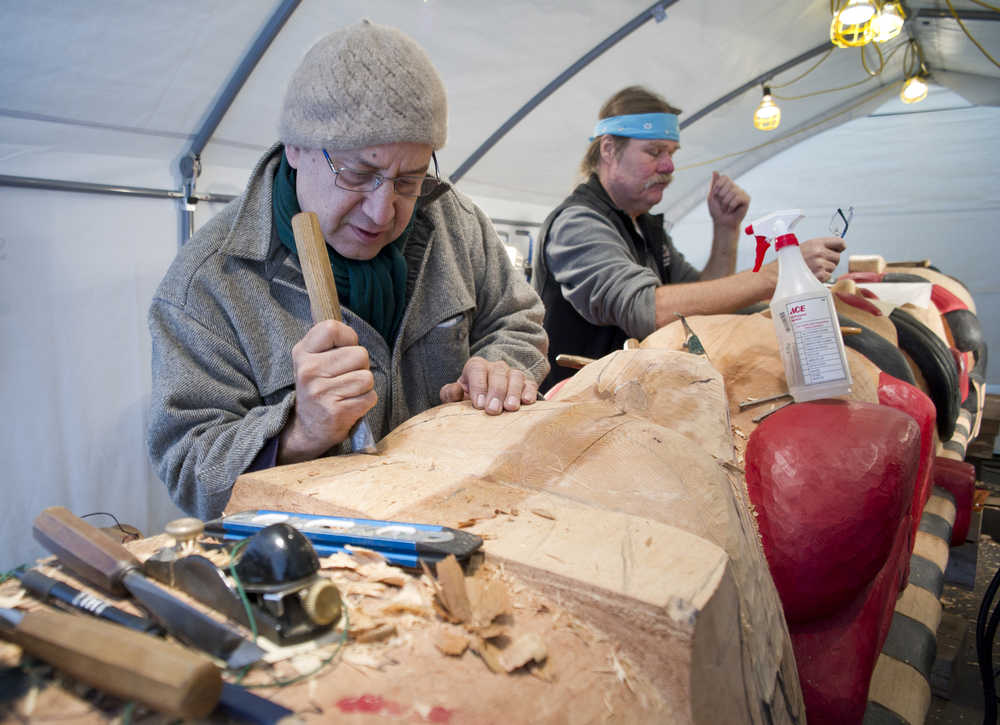For the last decades, nothing has marked South Douglas as traditional Taku and Auk Khwaan land.
That will change next year with two healing totem poles: A raven pole will rise in front of Gastineau Elementary School to mark Tlingit burial grounds discovered during the school’s expansion in 2012, and an eagle pole will rise in Savikko Park in 2018 to commemorate the Douglas Indian Village. The village was the winter residence for the Taku Khwaan, who fished on the Taku River each summer. It was burned down by Douglas city officials in 1962 to make way for the Douglas harbor, an act and a legacy that still brings pain today.
Project
Mick Beasley has been the lead carver for the raven pole, with the help of Fred Fulmer. Apprentice carvers are Herb Sheakley, Jeffrey Isturis, and Elijah Marks. (Beasley joked that they are “Herb the Great, Jeffrey the Great and Elijah the Great. They’re all related.”) Renowned carver Nathan Jackson designed both poles.
It’s been a challenge interpreting someone else’s design, but also a learning experience, Beasley said.
It’s also been a challenge — and fun — working with apprentices who haven’t carved poles before, Fulmer said.
“I think, in a way, we’re all learning,” Beasley said.
“I’m learning stuff on here where it’s like I’m a brand new student,” Fulmer said. “Everybody here is being challenged.”
[Native ceremony honors dead at Gastineau]
The totem poles were originally the idea of Kevin Allen, a 2016 Thunder Mountain High School graduate who suggested them at a tribal membership Douglas Indian Association meeting a few years ago, said Goldbelt executive director Dionne Cadiente-Laiti. The raven pole will likely be complete in November; the eagle pole will be carved in 2018.
Design
The design of the 25-foot raven pole features a woodworm and the woman who raised it, an image from a Klukwan Gaanaxhteidi clan story. Above that are a frog, a diving raven, two baby ravens, and another raven at the very top. On the sides are a leader’s staff, a red coho, and a black dog salmon. The big dipper also represents the Auk Khwaan.
The frog also represents the Ganaxh.adí, who migrated down the Taku after the great flood, according to oral histories. The coho, said Goldbelt language and cultural specialist and DIA council member Paul Marks, represents ancestral grandchildren.
The log is a Sealaska log — western red cedar from the Craig/Klawock area.
[DIA: Gastineau remains were misidentified]
The site will also include a fire dish, a walkway and built-in lighting. This fits in with its purpose as a ku.eex’, in which people gather at the end of a grieving period to honor and feed the dead. Patterns in the walkway will convey water and king salmon — “Taku” means “where the king salmon go,” Goldbelt Heritage Institute project manager Fred White said. (There have been mistranslations of the word “Taku,” but White, Cadiente-Laiti and Marks agreed that this is the correct one.)
The speaker staff on the side of the raven totem conveys a stamping out of grief, Cadiente-Laiti said. “With the fire dish and the staff, it’s almost like there is a ku.eex’,” Cadiente-Laiti said. “Right there at that site.”
Other aspects of the project
Both totems are funded by a three-year master-apprentice grant aimed at preservation of traditional arts.
“It doesn’t end with the pole when they’re done,” said White.
Another part of the project uses the wood cut away from the totem pole to make box drums for elementary school students, White said. They’ll also create a five-by-eight foot yellow cedar clan house screen for Harborview. Some of the older kids in the Tlingit Culture, Language and Literacy program will help paint in the formline patterns.
Elders and youth are gathering monthly throughout the entire project to work towards healing, Cadiente-Laiti said. The first gathering was in September.
[Healing history and undoing the silence: Totem poles to shine light on Douglas atrocities]
“Healing includes many things,” she said. “Language, culture, art. It’s really acknowledging the importance of our people and culture and language.”
While they are healing poles, the totems do not signify acceptance of what has happened, said Marks.
“It’s an honoring of our ancestors who were buried there, and those that were there before they were. It’s not to say to the community that everything is fine and dandy,” he said.
“In our way of thinking, it’s no good to hold on to sorrow,” he added. “When you do that, it’s like you’re holding onto death.”
“When you destroy a village, basically you’re destroying people,” Cadiente-Laiti said. “Their heritage, their ties to land. This hopefully reaffirms and reestablishes some of what was lost.”
• Contact Capital City Weekly editor Mary Catharine Martin at maryc.martin@capweek.com.
Correction: In an earlier version of this article, the word “khwaan” was mispelled as “kwaan.”

